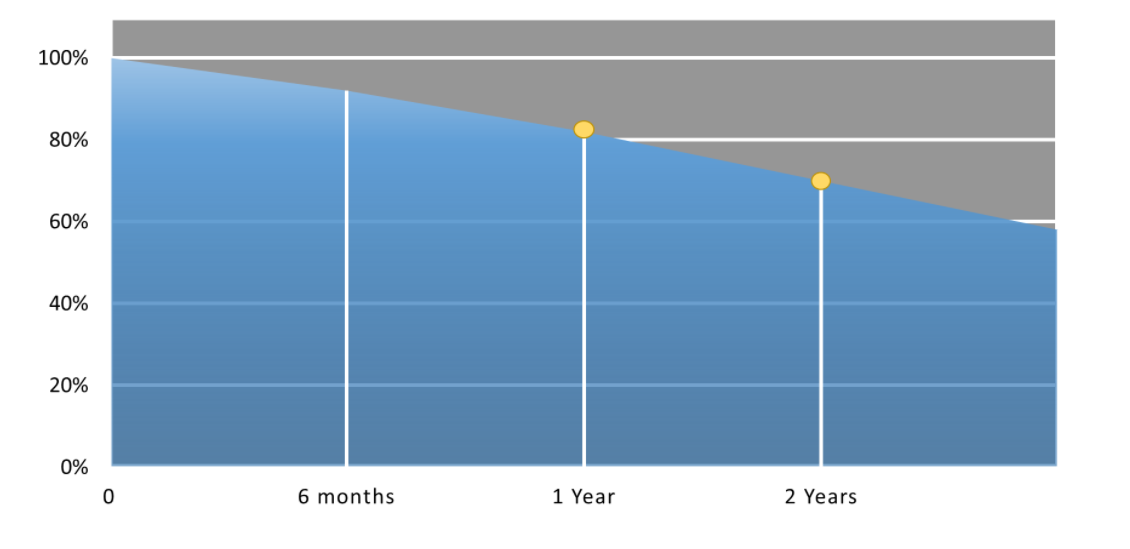ASUS Battery Information Center
Atualização mais recente : 2022/05/29
Battery lifecycle
- Due to the chemical properties of Lithium ions, battery capacity decreases gradually with use over time. This is a normal phenomenon.
- The life of a Li-ion battery is approximately between 300-500 cycles. Under normal usage conditions and in ambient temperatures (25℃), the Li-ion battery is expected to discharge and recharge normally for 300 cycles (or about one year). Afterwards the battery capacity will drop to 80% of its initial capacity.
- Battery life decline varies with the system design, model, system power consumption, program and operating software consumption, and power management settings. High/low operating temperatures and abnormal operations may result in 60% or more rapid decrease of the battery’s life cycle within a short time.

- The battery’s discharge rate depends on the laptop’s or tablet’s software operations and power management settings. For example, running computation-heavy programs, such as graphics software, gaming software, and video playing, consumes more power than running general word processing software. When a battery-charged laptop is externally connected to additional USB or Thunderbolt devices, the battery power will also discharge faster.
Battery protection mechanisms
- Frequently charging a battery under high voltage will quicken its aging. To extend battery life, when a battery maintains 90%-100% power after being fully charged, the system may not recharge due to battery protection mechanisms.
* A battery’s charge initiation capacity (%) is usually set between 90%-99%. The actual value will differ by model.
- Batteries charged or stored under high ambient temperatures may have permanently damaged capacity and accelerated battery life decline. When the battery temperature is too high or becomes overheated, battery charging capacity will be limited or even stop. This is part of the system’s battery protection mechanisms.
Battery aging
- Batteries are essentially consumables. Li-ion batteries, featuring continuous chemical reactions, will naturally decline over time and lose capacity.
- After using a battery for some time, under some conditions it will have a degree of swelling. This will not create safety issues.
- Swollen batteries should be replaced and discarded properly, though they do not create safety issues. When replacing swollen batteries, do not discard the old swollen battery into common domestic waste. Contact your local ASUS customer service to dispose of batteries (https://www.asus.com/support/CallUs).
Standard battery care
- If a laptop, cell phone, or tablet will not be used for a long time, charge the battery to 50%, turn the device off, and remove the AC power supply (adapter). Recharge the battery every three months to 50% to prevent battery damage by over-discharge due to long-term storage without using.
When AC power supply is used constantly for laptops, cell phones, or tablets, the user should discharge the battery to 50% at least once every two weeks to release the battery from persisting high voltage which may reduce battery life. Laptop users may extend battery life through the ASUS Battery Health Charging software.
- The best storage conditions for batteries are ambient temperatures between 10°C - 35°C (50°F - 95°F), charge maintained at 50%, and battery life extended with ASUS Battery Health Charging software.
- Avoid storing batteries in damp environments which may give increased battery discharge rates. Over-low temperatures will impair the battery’s internal chemicals, while batteries with over-high temperatures are under risk of explosion.
- Do not place your computer, cell phone, or battery pack near radiators, fireplaces, furnaces, electric heaters, or other heat-producing equipment close by heat sources over 60℃ (140°F). Overheating the battery may cause it to explode or leak, leading to risk of fire.
Battery optimization settings
Users may leave transformers connected to laptops, cell phones, or tablets during use, making the batteries remain under high charge, which may reduce battery life. To protect the battery under such use, laptop users may extend battery life through the ASUS Battery Health Charging software.
ASUS Battery Health Charging introduction
https://www.asus.com/support/FAQ/1032726/
2017 Q4 launch models include this APP
ASUS battery warranty regulations
- ASUS provides battery warranty covering the below:
- During the battery warranty period (refer to the product warranty card for the battery warranty date), should battery failure cause the machine to become unbootable, reboot/turn off irregularly by itself, or power off irregularly, we will exchange your battery for you.
- During the battery warranty period, should the battery fail to hold charge, or if the system cannot detect the battery, keeps displaying “please change battery,” or if the charging light blinks in error (i.e., battery cannot charge normally), we will exchange your battery for you.
- Damages caused by the following reasons are not covered by the warranty
- Reduced capacity due to normal decline
- Failures and damages due to self or non-original manufacturer repairs, taking apart and reassembly, or unauthorized specification changes, or non-original manufacturer parts.
- Moisture damaged internal battery wiring/connectors, or severe oxidation and rusting of electronic parts due to liquid seepage.
- Other irregular uses
ASUS battery introduction
Li-ion battery
Benefits of Li-ion batteries include high energy density, large power capacity, light weight, high cycle life, no memory effect, and fast charging. They have been widely used in consumer products such as mobile phones, laptops, and tablets.